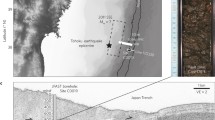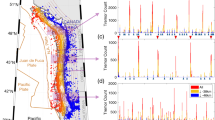Abstract
—Crackmeter data from the southern tip of the Imperial fault in the Mexicali-Imperial Valley in northern Baja California, Mexico, show slip events that tend to group in episodes, or suites, that last over a few days, with months of quiescence between them. The events in these suites are apparently triggered and stopped by ground strain related to temperature changes. A characteristic decrease in peak extension velocities during the slip event suites indicates the presence of viscoelastic afterworking which contributes the strain necessary for succeeding events with diminishing driving stresses, and which can be roughly modeled as a series of Kelvin-Voigt viscoelastic solids. Occurrence of very small events towards the end of the suites plus gaps between suites indicate that for the sediments significant fault healing requires a minimum of several days without slip.
Similar content being viewed by others
Author information
Authors and Affiliations
Additional information
Received February 21, 1999, accepted March 20, 1999
Rights and permissions
About this article
Cite this article
Nava, F., Glowacka, E. Fault-slip Triggering, Healing, and Viscoelastic Afterworking in Sediments in the Mexicali-Imperial Valley. Pure appl. geophys. 156, 615–629 (1999). https://doi.org/10.1007/s000240050315
Issue Date:
DOI: https://doi.org/10.1007/s000240050315




